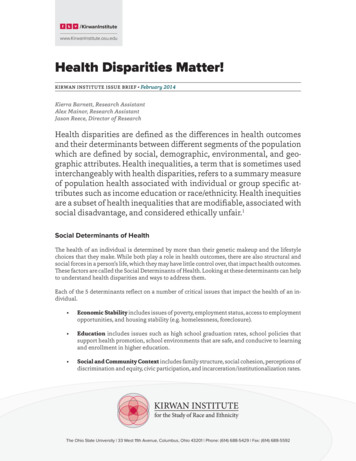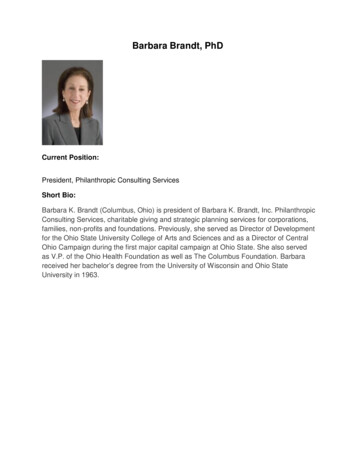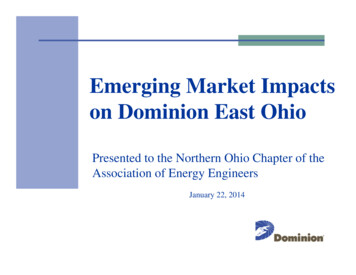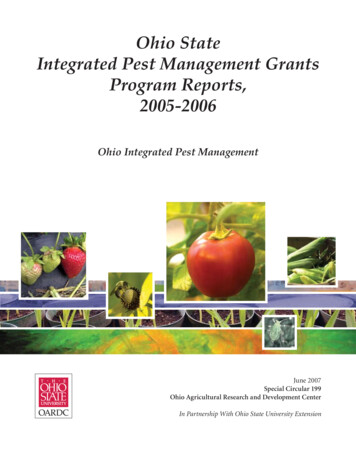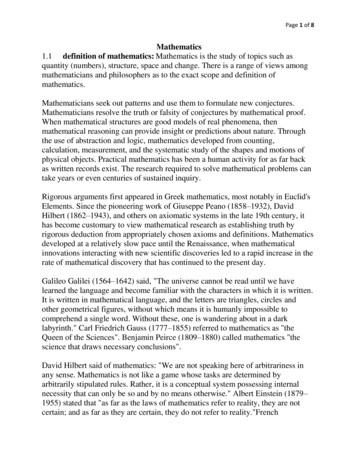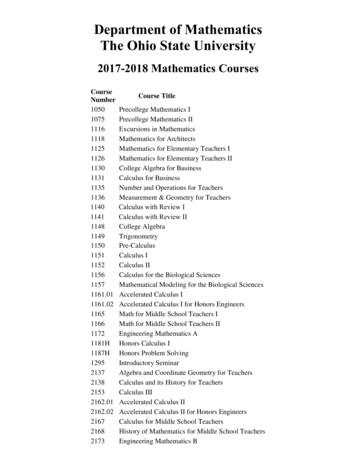
Transcription
Department of MathematicsThe Ohio State University2017-2018 Mathematics 2.012162.02216721682173Course TitlePrecollege Mathematics IPrecollege Mathematics IIExcursions in MathematicsMathematics for ArchitectsMathematics for Elementary Teachers IMathematics for Elementary Teachers IICollege Algebra for BusinessCalculus for BusinessNumber and Operations for TeachersMeasurement & Geometry for TeachersCalculus with Review ICalculus with Review IICollege AlgebraTrigonometryPre-CalculusCalculus ICalculus IICalculus for the Biological SciencesMathematical Modeling for the Biological SciencesAccelerated Calculus IAccelerated Calculus I for Honors EngineersMath for Middle School Teachers IMath for Middle School Teachers IIEngineering Mathematics AHonors Calculus IHonors Problem SolvingIntroductory SeminarAlgebra and Coordinate Geometry for TeachersCalculus and its History for TeachersCalculus IIIAccelerated Calculus IIAccelerated Calculus II for Honors EngineersCalculus for Middle School TeachersHistory of Mathematics for Middle School TeachersEngineering Mathematics B
15520H5522H5529H5530H5540H5576HCourse TitleLinear Algebra & Differential Equations for EngineersMathematical Topics for EngineersHonors Calculus IIDifferential Equations and Their ApplicationsIntroduction to Discrete MathematicsOrdinary and Partial Differential EquationsLinear AlgebraFoundations of Higher MathematicsIntroduction to Mathematical BiologyMathematical Foundations of Actuarial SciencePracticum in Actuarial ScienceIntroduction to Financial MathematicsBeginning Scientific ComputingTheory of InterestHonors Analysis IHonors Analysis IIQuantitative NeuroscienceHistory of MathematicsGeometryPartial Differential Equations for Science & EngineeringProbabilityAnalysis OverviewIntroductory Analysis IIntroductory Analysis IIVector AnalysisComplex AnalysisDynamical SystemsPartial Differential EquationsLinear Algebra for Engineering Graduate StudentsElementary Number TheoryCombinatorial MathematicsDiscrete Mathematical ModelsAbstract Algebra IAbstract Algebra IIHonors Linear Algebra and Differential EquationsHonors Complex AnalysisHonors CombinatoricsHonors ProbabilityHonors Differential GeometryHonors Number Theory
Course TitleHonors Abstract Algebra IHonors Abstract Algebra IILife Contingencies ILife Contingencies IIFinancial Economics for ActuariesLoss Models ILoss Models IIMathematical Methods in Relativity Theory IMathematical Methods in Relativity Theory II
Mathematics 1050Precollege Mathematics IAutumn, Spring5 creditsCatalog Description:Fractions and decimals, basic algebra, graphing lines, factoring, systems of equations. Credit forthis course will not count toward graduation in any degree program.Prerequisite:Math Placement Level T; or Math 1040 or 40 or 50; or permission of department.Exclusions:Not open to students with credit for any Math course above 1050 (050).Purpose of Course:Mathematics 1050 is designed to meet the needs of the students entering The Ohio StateUniversity at the lowest placement, course code T. This course will prepare students for Math1075.Follow-up Course:Math 1075Sequencing Chart:Text:Beginning Algebra, 8th edition, by Aufmann & Lockwood, Cengage, ISBN: 9781305942653Page 12017-2018Math 1050
Mathematics 1050Precollege Mathematics IAutumn, Spring5 creditsTopics oduction to IntegersOperations with IntegersRational NumbersAddition of Fractions using Least Common DenominatorExponents and the Order of OperationsConcepts from GeometryEvaluating Variable ExpressionsSimplifying Variable ExpressionsTranslating Verbal Expressions into Variable ExpressionsIntroduction to EquationsApplications of Equations of the Form 𝑎𝑥 𝑏General EquationsInequalitiesMidterm 14.1Translating Sentences into EquationsApp.2 Integer, Coins, and Stamps Problems4.2Geometry Problems4.3Markup and Discount Problems4.4Investment Problems4.5Mixture Problems4.6Uniform Motion Problems4.7Inequalities5.1The Rectangular Coordinate System5.2Graphs of Straight LinesMidterm 25.3Slopes of Straight Lines5.4Equations of Straight Lines5.6Graphing Linear Inequalities6.1Solving Systems of Linear Equations by Graphing6.2Solving Systems of Linear Equations by the Substitution Method6.3Solving Systems of Linear Equations by the Addition Method6.4Application Problems in Two Variables7.1Addition and Subtraction of Polynomials7.2Multiplication of Monomials7.3Multiplication of Polynomials7.4Integer Exponents and Scientific Notation7.5Division of PolynomialsMidterm 38.1Common Factors8.2Factoring Polynomials of the Form 𝑥 2 𝑏𝑥 𝑐8.3Factoring Polynomials of the Form 𝑎𝑥 2 𝑏𝑥 𝑐8.4Special Factoring8.5Factoring Polynomials Completely8.6Solving EquationsFinalPage 22017-2018Math 1050
Mathematics 1075Precollege Mathematics IIAutumn, Spring4 creditsCatalog Description:Algebraic, rational, and radical expressions; functions and graphs; quadratic equations; absolutevalue; inequalities; and applications.Prerequisite:Math Placement Level S, a grade of C– or better in Math 1050, or credit for Math 75 or 1074.Exclusions:Not open to students with credit for any higher numbered math class, or for any quarter math classnumbered higher than 75.Text:Beginning and Intermediate Algebra (4th ed), OSU Custom version, Miller, O'Neill & Hyde,McGraw-Hill, ISBN 9781259541650Follow-up Courses: Math 1116 for students in liberal arts or students in the precertification programs onregional campuses. Math 1125 for students intending to pursue a M.Ed. in early or middle childhood. Math 1130 College Algebra for Business Math 1148 Traditional College AlgebraSequencing Chart:Page 12017-2018Math 1075
Mathematics 1075Precollege Mathematics IIAutumn, Spring4 creditsTopics List:Ch. 4 Linear Inequalities4.1Solving linear inequalities using addition & subtraction4.2Solving linear inequalities using multiplication & division4.3Solving compound inequalities4.4Solving absolute value equations & inequalities4.5Graphing systems of inequalities in two variablesCh. 6 Factoring Polynomials6.1Introduction to factoring polynomials6.2Factoring trinomials of the form x 2 bx c6.3Factoring trinomials of the form ax 2 bx c6.4Factoring special binomials6.5Factoring by grouping; General strategies for factoring6.6Solving equations by factoringCh. 9 Rational Functions9.1Graphs of rational functions9.2Reducing rational expressions; Multiplying and dividing rational expressions9.3Adding and subtracting rational expressions9.4Combining operations; Complex rational expressions9.5Solving equations containing rational expressions9.6Inverse and joint variation; Other applications yielding equations with fractionsCh. 7 Solving Quadratic Equations7.1Extraction of roots and properties of square roots7.2Solving quadratic equations by completing the square7.3The quadratic formula7.4Applications of quadratic equations7.5Complex numbers; Solving quadratic equations with complex solutionsCh. 8 Functions: Linear, Absolute Value, and Quadratic8.1Functions and representations of functions8.2Linear Functions8.3Absolute value functions8.4Quadratic functionsCh. 10 Square Root & Cube Root Functions and Rational Exponents10.1 Evaluating radical expressions10.2 Adding & subtracting radical expressions10.3 Multiplying & dividing radical expressions10.4 Solving equations containing radical expressions10.5 Rational exponents & radicalsPage 22017-2018Math 1075
Mathematics 1116Excursions in MathematicsAutumn, Spring3 creditsCatalog Description:Critical thinking and problem solving, with relevant topics met in everyday life. Appropriate fornon-science majors.Prerequisite:Math Placement Level R or higher; or credit for 1075, 75, 104, 1073 or 1074;or ACT math score 22 or SAT math score 520 (scores must be less than 2 years old).Exclusions:Not open to students with credit for Math 1152 or higher, or for quarter math class numbered 153or higher.Purpose of Course:The emphasis in this course is on intuitive understanding and developing some facility forapplying mathematical ideas to problem solving.Follow-up Courses:None. Math 1116 is a terminal course.Text:Excursions in Modern Mathematics, 8th edition, by Tannenbaum, Pearson,ISBN 9780321825735Topics List:1. Graph theory: graphs, Euler and Hamilton circuits, algorithms for Traveling SalesmanProblem, spanning trees, etc.2. Voting & apportionment: preference ballots; apportionment paradoxes; Congressionalapportionment; methods of Jefferson, Adams, and Webster.3. Patterns & growth: Fibonacci and recursive sequences, golden ratio, population growthmodels: linear, exponential, and logistic.4. Symmetry: Rigid motions, rosettes, friezes, rudiments of group theory.5. Counting & probability: counting principles, permutations and combinations,multiplication rule, randomness, probability.6. Fractals: recursive definitions, standard examples (Koch snowflake, Sierpinski gasketetc.), self-similarity, fractional dimension.7. Linear programming: mixture problems, examples in low dimension, corner pointprinciple, algorithms.Page 12017-2018Math 1116
Mathematics 1118Mathematics for ArchitectsAutumn, Spring3 creditsCatalog Description:Topics in geometry for architecture majors.Prerequisite:Enrollment in the School of Architecture and: Math Placement Level L or M; C- or better in1148 or 1150; or credit for 148 or 150.Purpose of Course:The majority of the audience is made up of Architecture majors for whom the course is arequirement. The intent of the course is to introduce these students to the mathematics inherent in2D and 3D design. Moreover, there is an emphasis on similar figures and the issues that arisewhen scaling lengths, areas, and volumes.Follow-up Courses:There are really no follow-up courses. To start any other mathematics sequence will probablyinvolve beginning at an appropriate entry level course. Students interested in further coursework in mathematics should consult the Mathematics Advisors in 250 Mathematics Bldg.Text:Course Notes, by SnappTopics List:1.2.3.4.5.6.7.8.Page 1Geometric models, transformations, matrices.Plane tessellations, concepts of symmetry.Polyhedra: Platonic and Archimedean.Invariants: area, volume, Euler characteristic.Mathematics of perspective drawing.String art: curves defined as envelopes of tangent lines, ruled surfaces.Discrete curvature: Descartes theorem and beyond.Higher dimensions: tesseracts and other 4-D polyhedra.2017-2018Math 1118
Mathematics 1125Mathematics for Elementary Teachers IAutumn, Spring5 creditsCatalog Description:Math 1125 involves numbers, operations, geometry, measurement, and mathematical reasoningfor prospective elementary school teachers.Prerequisite:A grade of C- or above in 1075; or credit for 1074, 75, or 104; or Math Placement Level R orabove; or ACT math score 22 or SAT math score 520 (scores must be less than 2 years old)and enrollment in Early Childhood or Special Education major, or in Middle Childhood major orpre-major with area of concentration different than Math.Exclusions:Not open to students with credit for 106.Purpose of Course:To develop an appreciation of, and basic competency in, the use of analytical thought in thedevelopment of a cohesive body of useful mathematical knowledge, with special emphasis ontopics encountered in elementary and middle school mathematics programs. Math 1125addresses the meaning of whole numbers, integers, rational numbers, and operations with these,number theory, and algebraic thinking. Appropriate only for those preparing to become earlychildhood educators and for those preparing to teach subjects other than math in middle school.Follow-up Courses:Math 1126.Text:Mathematics for Elementary Teachers, with Activity Manual, 4rd Edition, by Sybilla Beckmann,Pearson, ISBN for the package is 9780321836715 (loose-leaf) and Student Packet.Topics List:1. Counting and the decimal system.2. Fractions and integers and their meaning.3. Addition and subtraction of fractions, decimals, and integers.4. Multiplication of fractions, decimals, and integers.5. Division of fractions, decimals, and integers.6. Ratios and proportional reasoning.7. Number theory: factors and multiples, LCM, GCF, divisibility tests, prime numbers,unique factorization, notations for fractions and decimals.8. Algebraic thinking: writing expressions, solving equations, sequences.9. Problem solving and justification are themes of the course.*Currently taught in either lecture/recitation or workshop format.Page 12017-2018Math 1125
Mathematics 1126Mathematics for Elementary Teachers IIAutumn, Spring5 creditsCatalog Description:Continuation of 1125: Math 1126 involves geometry, measurement, number theory, algebraicthinking, counting techniques, probability, a mathematical reasoning for prospective elementaryschool teachers.Prerequisite:A grade of C- or above in 1125; and enrollment in Early Childhood or Special Education major,or in Middle Childhood major or pre-major with area of concentration different than Math.Exclusions:Not open to students with credit for 107.Purpose of Course:To develop an appreciation of, and basic competency in, the use of analytical thought in thedevelopment of a cohesive body of useful mathematical knowledge, with special emphasis ontopics encountered in elementary and middle school mathematics programs. Math 1126addresses basic geometric concepts and measurement, symmetry and rigid motions, congruence,similarity and scaling, coordinate geometry, algebraic thinking, linear functions, countingtechniques and probability. Appropriate for those preparing to become early childhoodeducators and for those preparing to teach subjects other than math in middle school.Text:Mathematics for Elementary Teachers, with Activity Manual, 4rd Edition, by Sybilla Beckmann,Pearson, ISBN for the package is 9780321836715 (loose-leaf) and Student Packet.Topics List:1. Spatial visualization and basic geometric concepts: angles, 2- and 3-D shapes and theirproperties.2. Measurement: meaning of length, area, volume, measurement techniques, unitconversion, actions preserving area/volume, and scaling.3. Transformations: symmetry, congruence, similarity.4. Geometric constructions with various tools (compass, paper folding).5. Algebraic thinking: expressions, measurement formulas, scaling, functions, use offormulas, graphs, and tables, sequences, and coordinate geometry.6. Counting: inclusion/exclusion, fundamental counting principle, tree diagrams,permutations and combinations, Pascal’s triangle.7. Basic ideas of probability: Law of Large Numbers, sample and event spaces, use of treediagrams, simulations, and discussion of common misconceptions.8. Problem solving and justifications at multiple levels are themes of the course.*Currently taught in either lecture/recitation or workshop format.Page 12017-2018Math 1126
Mathematics 1130College Algebra for BusinessAutumn, Spring4 creditsCatalog Description:Algebraic, exponential, and logarithmic functions. Matrix algebra. Applications to business.Prerequisite:Math Placement Level N; C- or better in 1075; or credit for 104; or ACT math score 22 or SATmath score 520 (scores must be less than 2 years old).Exclusions:Not open to students with credit for 1131 or for any math course numbered 1149 or higher, or aquarter-system math course numbered 150 or higher.Purpose of Course:Math 1130 is a pre-calculus course with a finance section slanted toward a business program.The applications are business related.Follow-up Course:Math 1131Text:Introductory Mathematical Analysis for Business, Economics, and the Life and Social Sciences,13th Edition; by Haeussler, Paul, and Wood; published by Pearson; ISBN 9780321732378Topics List:Ch. 1 Review of Algebra0.7Equations, In Particular Linear Equations.0.8Quadratic Equations.1.2Linear Inequalities.1.3Applications of Inequalities.1.6SequencesCh. 2 Functions2.1Functions.2.2Special functions.2.3Combinations of functions.2.4Inverse Functions.2.5Graphs of functionsPage 12017-2018Math 1130
Mathematics 1130College Algebra for BusinessAutumn, Spring4 creditsCh. 3 Linear and Quadratic Functions3.1Lines3.2Applications and Linear Functions.3.3Quadratic Functions3.4Systems of Linear Equations.3.6Applications of Systems of Equations.Ch. 4 Exponential and Logarithmic Functions4.1Exponential Functions.4.2Logarithmic functions.4.3Properties of Logarithms.4.4Logarithmic and Exponential Equations.Ch. 5 Mathematics of Finance5.1Compound Interest.5.2Present Value.5.3Interest Compounded Continuously.5.4Annuities5.5Amortization of Loans.Ch. 6 Matrix Algebra6.1Matrices.6.2Matrix Addition and Scalar Multiplication.6.3Matrix Multiplication.6.4Solving Systems by Reducing Matrices.6.6InversesPage 22017-2018Math 1130
Mathematics 1131Calculus for BusinessAutumn, Spring5 creditsCatalog Description:Survey of calculus of one and several variables; applications to business.Prerequisite:Math Placement Level L; C- or better in 1130, 1148, 1144, or 1150; credit for 130 or 148.Exclusions:Not open to students with credit for a math course numbered 1151 (151.xx) or higher, or for 132or 1134.Text:Introductory Mathematical Analysis for Business, Economics, and the Life and Social Sciences,13th Edition, by Haeussler, Paul, Wood, published by Pearson: ISBN-10: 1-256-96609-6,ISBN-13: 978-1-256-96609-8.Topics its (Continued)ContinuityContinuity and InequalitiesThe DerivativeRules of DifferentiationDerivatives and Rates of ChangeThe Product and Quotient RulesThe Chain RuleMidterm 2Midterm rivatives of Logarithmic FunctionsContinuously Compounded InterestedDerivatives of Exponential FunctionsImplicit DifferentiationLogarithmic DifferentiationHigher-Order DerivativesDifferentialsRelative ExtremaExtrema on Closed IntervalsConcavityThe Second-Derivative TestAsymptotesPage ied Maxima and MinimaThe Indefinite IntegralIntegration with Initial ConditionsMore Integration FormulasTechniques of IntegrationThe Definite IntegralThe Fundamental Theorem of CalculusThe Area Between CurvesConsumers’ and Producer’s SurplusDifferential EquationsPartial DerivativesMidterm 317.217.417.617.72017-2018Applications of Partial DerivativesHigher-Order Partial DerivativesMaxima/Minima Functions of 2 VariablesLagrange MultipliersMath 1131
Mathematics 1135Number and Operations for TeachersAutumn, Spring5 creditsCatalog Description:This course is the first in a two semester sequence for teachers of elementary and middle gradestudents. This course focuses on concepts of numbers and arithmetic operations, including modernand historical perspectives.Prerequisite:A grade of C- or above in 1075; or credit for 1074, 75, or 104; or Math Placement Level R orabove; or ACT math subscore of 22 or higher that is less than 2 years old.Exclusions:Not open to students with credit for 106.Text:Mathematics for Elementary Teachers, with Activity Manual, 4th Edition, by Sybilla Beckmann,Pearson, ISBN for the package is 9780321836715 (loose-leaf).Purpose:This course covers the concepts of whole numbers (positive and negative), place value (base-tenand alternate bases), decimals, and fractions. Some content on irrational numbers appears at theend, and this is extended in Algebra and coordinate geometry for teachers (2137). The fourarithmetic operations are covered both conceptually and algorithmically. Attention is given toensuring that students can perform the algorithms correctly and explain why they give accurateanswers. Lastly, the course covers the concepts of proportions and how they are related both tomultiplication/division and to fractions. Factors, divisibility, and some elementary number theorycomplete the course.Topics List:1. Counting numbers, decimals2. Meaning of fractions3. Meaning of addition and subtraction4. Meaning of multiplication5. Multiplying fractions, decimals, integers6. Meaning of division7. Dividing fractions, decimals, integers8. Meaning of ratios, rates, proportions9. Greatest common divisor, least common multiple10. Rational and irrational numbersPage 12017-2018Math 1135
Mathematics 1136Measurement & Geometry for TeachersAutumn, Spring5 creditsCatalog Description:This course is the second in a two semester sequence for teachers of elementary and middlegrade students. This course focuses on concepts of measurement and geometry, includingmodern and historical perspectives.Prerequisite:A grade of C- or above in “Number and Operations for Teachers” (Math 1135)Text:Mathematics for Elementary Teachers, with Activity Manual, 4th Edition, by Sybilla Beckmann,Pearson, ISBN for the package is 9780321836715 (loose-leaf).Recommended Supplemental Texts: Geometric Structures: An Inquiry-Based Approach for Prospective Elementary andMiddle School Teachers, by Douglas Aichele and John Wolfe, Pearson, ISBN9780131483927 Elementary Geometry for Teachers, by Thomas Parker and Scott Baldridge, Sefton-AshPublishing, ISBN 9780974814056Purpose:The course consists of fundamental topics in Euclidean geometry starting with measurement.This includes the concepts of length, area, volume, angles, units of measurement, precision anderror.The basic properties of two and three dimensional geometric shapes and their relationships are acentral part of the course. Special emphasis is put on geometric reasoning through problemsolving, including unknown angle, length, area, and volume. The course also covers topics ontransformations in the plane, symmetries, congruence, and similarity. Some geometricconstructions and basic geometric proofs are included.Additional topics include an introduction to functions and equations, primarily in the linear case,and a brief introduction to probability.Topics List:1. Measurement2. Planar shapes3. Polyhedra4. Plane geometry5. Transformations in the plane, congruence, symmetry6. Linear equations and graphs7. Algebra and linear equations8. ProbabilityPage 12017-2018Math 1136
Mathematics 1140Calculus with Review IAutumn4 creditsCatalog Description:This is the first of a two semester course sequence. The topics covered in Math 1140 will includedifferential calculus of one real variable, with review of important algebra and pre-calculusconcepts. Calculus with Review I is a course designed with an emphasis on reviewing thesefundamental pre-calculus skills as they apply to calculus.Prerequisite:A grade of C- or above in 1148 and 1149, or in 1144, 1150, or 150, or Math Placement Level L.Exclusions:Not open to students with credit for 1141, or 1151 or above, or 151.xx or above.Text:calculus with review developed by XIMERATopics List:I.1I.2I.3I.4I.5I.6I.7I.8I.9Equations and InequalitiesUnderstanding functionsWhat is a limit?Polynomial functionsRational functionsLimit laws(In)determinate formsUsing limits to detect asymptotesContinuity and the Intermediate Value TheoremMidterm 1II.10II.11II.12II.13II.14II.15An application of limitsDefinition of derivativeDerivatives as functionsRules of differentiationProduct rule and quotient ruleChain RuleMidterm 2Page 12017-2018Math 1140
Mathematics 1140Calculus with Review IAutumn4 tial and Logarithmic functionsDerivatives of exponential functionsHigher order derivatives and graphsTrigonometric functionsDerivatives of trigonometric functionsMaximums and minimumsMidterm 3IV.22 Mean Value TheoremIV.23 OptimizationIV.24 Applied optimizationFinalPage 22017-2018Math 1140
Mathematics 1141Calculus with Review IISpring4 creditsCatalog Description:This is the second of a two semester course sequence. The topics covered in Math 1141 will includedifferential calculus of one real variable, with review of important algebra and pre-calculusconcepts. Math 1141 is a course designed with an emphasis on reviewing these fundamental precalculus skills as they apply to calculus.Prerequisite:A grade of C- or above in 1140.Exclusions:Not open to students with credit for 1151 or above, or 151.xx or above.Text:calculus with review developed by XIMERATopics List:V.25V.26V.27V.28V.29V.30Review of LimitsReview of differentiationLinear approximationConcepts of graphing functionsImplicit differentiationLogarithmic differentiationMidterm 1VI.31VI.32VI.33VI.34VI.35VI.36VI.37Inverse Trigonometric FunctionsDerivatives of inverse trigonometric functionsMore than one rateApplied related ratesL’Hopital’s ruleAntiderivativesDifferential EquationsMidterm 2VII.38VII.39VII.40VII.41VII.42VII.43Page 1Approximating the area under a curveDefinite integralsAntiderivatives and areaFirst Fundamental Theorem of CalculusSecond Fundamental Theorem of CalculusApplications of integrals2017-2018Math 1141
Mathematics 1141Calculus with Review IISpring4 creditsMidterm 3VIII.44VIII.45The idea of substitutionWorking with substitutionFinalPage 22017-2018Math 1141
Mathematics 1148College AlgebraAutumn, Spring, Summer4 creditsCatalog Description:Functions: polynomial, rational, radical, exponential, and logarithmic. Introduction to right-angletrigonometry. Applications.Prerequisite:Math Placement Level N; C- or better in 1075; or credit for 104 or 148; or ACT math score 22or SAT math score 520 (scores must be less than 2 years old).Exclusions:Not open to students with credit for 1144 or 1150 or higher, or for a quarter-system math coursenumbered 150 or higher.Purpose:College Algebra provides students a college level academic experience that emphasizes the use ofalgebra and functions in problem solving and modeling, where solutions to problems in real-worldsituations are formulated, validated, and analyzed using mental, paper-and-pencil, algebraic andtechnology-based techniques as appropriate using a variety of mathematical notation. Studentsshould develop a framework of problem-solving techniques (e.g., read the problem at least twice;define variables; sketch and label a diagram; list what is given; restate the question asked; identifyvariables and parameters; use analytical, numerical and graphical solution methods as appropriate;determine the plausibility of and interpret solutions). – Adapted from the MAA/CUPM CRAFTY2007 College Algebra Guidelines. This course is intended to satisfy the requirements of the OhioBoard of Regents TMM001 College Algebra course with learning outcomes specified ng-outcomes.phpText:College Algebra & Trigonometry, 1st Edition, by Miller and Gerken, published by McGraw-Hill.ISBN: 9781259976612Technology: All students are required to have a graphing calculator, TI-83 or TI-84.Note: Any calculators (including TI-89 and TI-92) that use a Computer Algebra System(CAS) are not permitted.Page 12017-2018Math 1148
Mathematics 1148College AlgebraAutumn, Spring, Summer4 creditsSequencing Chart:Topics List:Week 1Week 2Week 3Week 4Week 5Week 6Week 7Week 8Week 9Week 10Week 11Week 12Week 13Week 14Page 2Section 1.7 – InequalitiesSection 2.3 – Functions and RelationsSection 2.4 – Linear Equations in Two VariablesSection 2.5 – Applications of Linear EquationsSection 9.1 – Systems of Linear Equations in Two VariablesSection 9.2 – Systems of Linear Equations in Three VariablesSection 2.6 – Transformations of GraphsSection 2.7 – Analyzing Graphs of FunctionsTest 1Section 2.8 – Algebra of Functions and CompositionSection 3.1 – Quadratic Functions and ApplicationsSection 3.2 – Polynomial FunctionsSection 3.3 – Division of PolynomialsSection 3.5 – Rational FunctionsSection 3.5 – Rational FunctionsSection 3.6 – Polynomial and Rational InequalitiesTest 2Section 4.1 – Inverse FunctionsSection 4.2 – Exponential FunctionsSection 4.2 – Exponential FunctionsSection 4.3 – Logarithmic FunctionsSection 4.3 – Logarithmic FunctionsSection 4.4 – Properties of LogarithmsSection 4.4 – Properties of LogarithmsSection 4.5 – Exponential and Logarithmic EquationsSection 4.6 – Modeling with Exponential and Logarithmic FunctionsComprehensive review, Final Exam2017-2018Math 1148
Mathematics 1149TrigonometryAutumn, Spring, Summer3 creditsCatalog Description:Trigonometric functions and their properties. Vectors, polar coordinates and complex numbers.Prerequisite:C- or better in 1148, or permission of department.Exclusions:Not open to students with credit for 1144, or for any math course numbered 1150 or higher.Text:College Algebra & Trigonometry Mathematics 1e, by Miller and Gerken, ISBN 9781259976612.This textbook is packaged with an access code to Connect Math for a period of 720 days. It maybe purchased at the bookstore or online via Carmen/Canvas.Technology:A graphing calculator is a required component in this course. It is recommended that you use a TI83, TI-83 plus, or a TI-84. Note that the TI-89, TI-92, and calculators that use aComputer Algebra System are not permitted.Topics List:5.15.25.35.45.55.6Angles and Their MeasureRight Triangle TrigonometryTrigonometric Functions of any AngleTrigonometric Functions and the Unit CircleGraphs of Sine and Cosine Functions. Omit sinusoidal behavior.Graphs of Other Trigonometric Functions.Midterm 15.76.16.26.36.57.27.3Inverse Trigonometric Functions. Omit inverse cot(t), sec(t), and csc(t).Fundamental Trigonometric IdentitiesSum and Difference FormulasDouble-Angle and Half-Angle FormulasTrigonometric Functions. Solving graphically is optional.The Law of SinesThe Law of CosinesMidterm 2Page 12017-2018Math 1149
Mathematics 1149TrigonometryAutumn, Spring, Summer3 credits8.38.48.511.111.211.3Page 2Complex Numbers in Polar Form. Omit nth roots of complex numbers.VectorsDot ProductThe Ellipse. Centered at the origin only
6.4 Factoring special binomials 6.5 Factoring by grouping; General strategies for factoring 6.6 Solving equations by factoring . Patterns & growth: Fibonacci and recursive sequences, golden ratio, population growth models: linear, exponential, and logistic. 4. Symmetry: Rigid motions, rosettes, friezes, rudiments of group theory.




